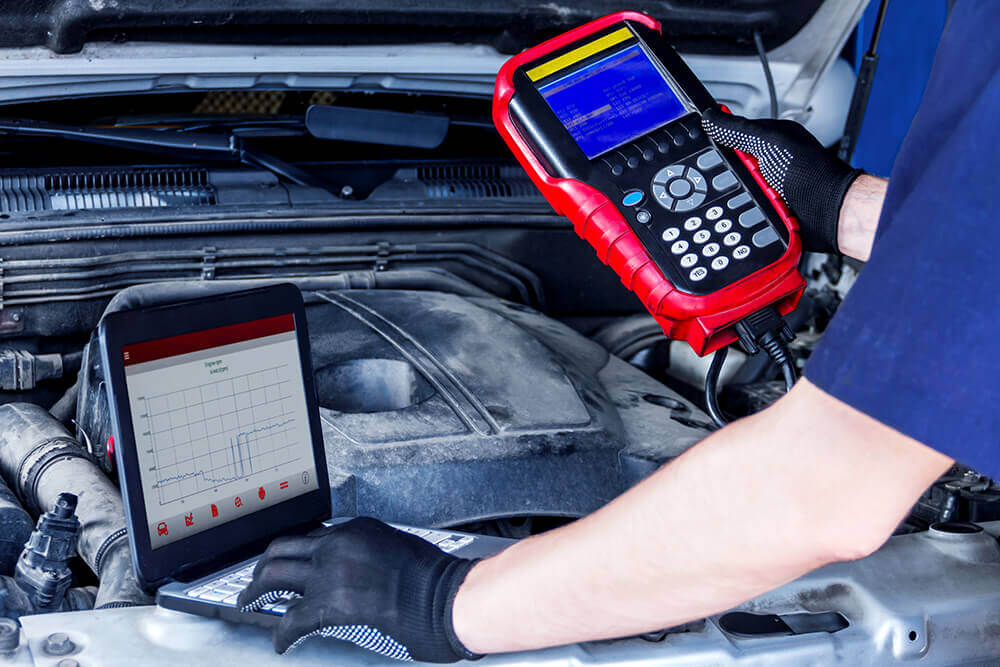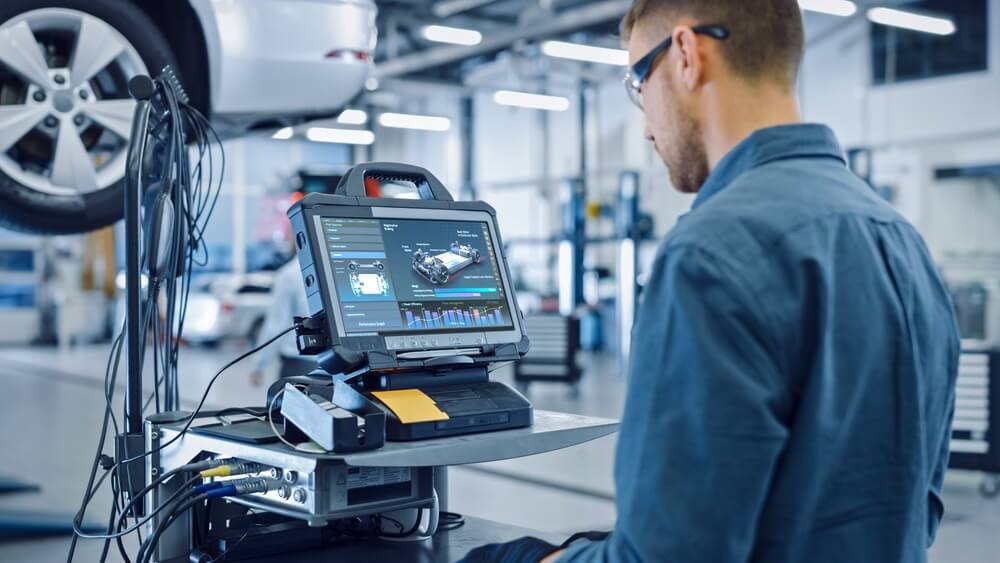When your car starts acting up, a diagnostic test can help you determine the root cause of the problem. Before you take your vehicle to a mechanic, it’s essential to know how long a car diagnostic test will take. This way, you can arrange your schedule accordingly and get back on the road as soon as possible. So, how long does a car diagnostic test take? The answer is that it depends. The time required to conduct the test depends on several factors, including the complexity of the problem, the type of vehicle, and the diagnostic tools used. This question will be answered well in this article. Read down to learn more about diagnostic tests, including their duration and cost.

How long does a car diagnostic test take?
The duration of a car diagnostic test can range from a few minutes to several hours. It usually takes an average of 30 minutes to an hour for a mechanic to perform a diagnostic test.
However, if the issue is more severe, it may take longer. The first step in a diagnostic test involves using an OBD-II scanner, which is a handheld device that connects to your car’s onboard computer system. The scanner reads the codes stored in the system and identifies any problems within the engine, transmission, and other vital components.
If the check engine light is on, it’s an indication that something is wrong with your car, and a diagnostic test is required. In this case, the mechanic may need to delve deeper into the problem to find out what’s causing the issue. Another factor that can affect the duration of a diagnostic test is the type of vehicle you have. Older cars are typically simpler in design, and issues can be diagnosed more easily.
Conversely, newer cars come with advanced computer systems and electronics, which make diagnosis more complicated. The use of advanced diagnostic tools can also speed up the process and help mechanics identify problems quickly. For example, some mechanics use a professional scan tool that can read all the codes in the vehicle’s computer system, even those that can’t be read by an OBD-II scanner.
Overall, it’s essential to be patient when conducting a diagnostic test. Rushing the process can lead to an inaccurate diagnosis, which can result in further damage to your vehicle. It’s better to take the time to identify and solve the problem correctly the first time than to rush it and end up with more significant issues later on.

What does a car diagnostic test consist of?
A car diagnostic test typically involves connecting a scanning tool to the vehicle’s onboard computer system to check for any trouble codes or faults. The test can identify issues with the engine, transmission, brakes, and other systems, as well as provide valuable information about performance and fuel efficiency. The scanning tool can also reset certain codes and turn off warning lights. Overall, a car diagnostic test is an important tool for identifying and fixing problems with a vehicle.
What happens during a diagnostic test?
During a diagnostic test, a technician will connect a scanning tool to the vehicle’s onboard computer system. This will allow them to access information about the car’s performance, including any trouble codes or faults that may have been detected. The technician will then review this information to determine the cause of any issues or warning lights that may have been activated. Depending on the results of the test, the technician may need to perform further inspections or repairs to resolve any problems. Overall, a diagnostic test is an important part of keeping a vehicle running smoothly and ensuring that it remains safe to drive.
How long does an OBD scan take?
An OBD (on-board diagnostics) scan typically takes only a few minutes, depending on the complexity of the issue being diagnosed. During the scan, the OBD system in a vehicle retrieves and analyzes data from various sensors and components to identify any issues or malfunctions. The results of the scan are displayed on a diagnostic scanner, which can be used by a mechanic or vehicle owner to pinpoint the problem and determine the necessary repairs. Overall, an OBD scan is a quick and efficient way to diagnose automotive problems.
How much does it cost to get a diagnostic test on a car?
The cost of getting a diagnostic test on a car can vary depending on the location, type of vehicle, and complexity of the issue being diagnosed. Typically, the cost can range from $50 to $150 for a basic diagnostic scan, which involves retrieving error codes from the vehicle’s OBD system. However, if the issue requires more in-depth inspection or testing, the cost could rise significantly. It’s important to note that some auto shops may offer a free diagnostic test with a repair service, so it’s worth checking with local mechanics or dealerships to find the best price.
How do I run a full diagnostic on my car?
To run a full diagnostic on your car, you will need an OBD-II scanner tool. This tool plugs into the OBD-II port, which is usually located under the dashboard on the driver’s side. Once connected, turn on the ignition and allow the scanner to run a full scan of the car’s systems. The scanner will then display any fault codes that may be present, allowing you to identify any issues with the engine or other systems. From there, you can either attempt to fix the issue yourself or take it to a mechanic for repair.
Will an OBD scanner tell me what’s wrong with my car?
Yes, an OBD (on-board diagnostics) scanner can tell you what’s wrong with your car. It is a diagnostic tool that reads the codes generated by your car’s computer system and displays them on a screen. These codes can give you insight into specific issues that your vehicle may be experiencing, such as engine misfires, faulty oxygen sensors, or issues with the transmission. However, it is important to note that while an OBD scanner can provide valuable information, it does not necessarily pinpoint the exact problem and may require further investigation by a trained mechanic.
How do I know when my OBD is done?
When your OBD (on-board diagnostics) is done, the diagnostic tool will indicate that it has completed its scan. This can vary depending on the type of tool you are using, but typically a message or notification will appear on the tool’s screen indicating that the scan is complete. Additionally, if there are any issues detected during the scan, the tool will display error codes or alerts to indicate what specific problems have been found. It’s important to note that even after the scan is complete, the OBD system will continue to monitor your vehicle for any issues that may arise while driving.
How do I know if OBD is working?
To know if your OBD (On-Board Diagnostics) is working, you can try connecting an OBD scan tool to your vehicle’s OBD port. The OBD port is typically located beneath the dashboard on the driver’s side of the vehicle. Once the scan tool is connected, turn on the ignition and wait for the tool to establish a connection with the vehicle’s computer. If the scan tool is able to communicate with the vehicle’s OBD system, it will display information about the vehicle’s diagnostic codes, readiness status, and other parameters. Additionally, the OBD warning light on the dashboard should turn on briefly when the ignition is turned on and then turn off once the engine has started. If the OBD warning light remains on, it could indicate a problem with the OBD system that needs to be addressed.
What are the advantages of OBD?
OBD (On-Board Diagnostics) systems have several advantages. One of the main advantages is that they provide real-time information about a vehicle’s performance, helping drivers diagnose and correct problems quickly. Another advantage is that OBD systems can reduce emissions and improve fuel efficiency by detecting issues with the engine or emissions control systems. Additionally, OBD systems can help mechanics pinpoint problems more accurately, saving time and money on repairs. Finally, OBD systems can help government agencies monitor and enforce emissions standards, improving air quality for everyone.
What are the disadvantages of the OBD system?
While OBD (On-Board Diagnostics) systems have many advantages, there are also some disadvantages to consider. One disadvantage is that OBD systems are not foolproof and may not always accurately diagnose vehicle problems. This can lead to unnecessary repairs or missed issues that could affect performance and safety. Another disadvantage is that OBD systems can be expensive to repair or replace if they fail. Additionally, some people may feel uncomfortable with the idea that their vehicle’s performance is constantly monitored by a computer system. Finally, some mechanics may lack the expertise or equipment needed to diagnose and repair OBD-related issues, leading to longer repair times and higher costs for vehicle owners.
What problems can the OBD2 detect?
The On-Board Diagnostics 2 (OBD2) system is capable of detecting a wide range of issues related to a car’s performance and emissions. It can detect problems with the engine, transmission, brakes, and fuel system, as well as issues with the catalytic converter, oxygen sensors, and other components that affect emissions. OBD2 can also detect problems with the vehicle’s electrical system, including the battery, alternator, and starter. Additionally, it can detect faults in various sensors like the throttle position sensor, manifold absolute pressure sensor, and more. Overall, OBD2 is an essential diagnostic tool that provides valuable insights into a car’s performance and helps drivers maintain their vehicles in good working condition.
How long does it take for OBD to reset?
The time it takes for the On-Board Diagnostics (OBD) system to reset varies depending on the type of fault codes that were previously stored in the system. In some cases, the OBD system can reset itself in just a few minutes, while in other cases, it can take several days or even weeks. In general, the OBD2 system will reset itself after three consecutive driving cycles that are free of any detected faults. This means that the vehicle must be driven normally without any issues occurring during this time. However, there are also ways to reset the OBD system manually, such as by disconnecting the battery or using a diagnostic scanner tool. It is important to note that resetting the OBD system does not fix any underlying issues with the vehicle. It is just a way to clear the system of any previous fault codes to see if any new issues arise.
What systems can the OBD detect?
The On-Board Diagnostics (OBD) system can detect various systems and components of a vehicle, including the engine, transmission, emission control system, fuel system, and other related systems. The OBD system can also identify specific issues with these systems, such as faulty sensors or malfunctioning parts, and provide diagnostic trouble codes (DTCs) to help technicians pinpoint and repair the problem. Overall, the OBD system plays a critical role in monitoring and maintaining the health and performance of modern vehicles.
What sensor is used to detect engine misfires?
The crankshaft position sensor (CKP) is commonly used to detect engine misfires in modern vehicles. It measures the rotation of the crankshaft and communicates with the Engine Control Module (ECM) to determine if there is any loss of power during the combustion cycle. If the sensor detects a problem, it will trigger a fault code, which can be used to diagnose the issue and make necessary repairs.
What is the full form of OBD in a car?
OBD stands for On-Board Diagnostics. It refers to the computer system installed in modern vehicles that monitors and controls various engine and vehicle functions. The OBD system is responsible for detecting faults and problems within the vehicle, and it provides diagnostic information to mechanics and technicians to help them identify issues and make repairs. OBD systems have become increasingly sophisticated over the years, and they can now monitor everything from engine performance and emissions levels to fuel efficiency and overall vehicle health.

The recommended car diagnostic tool
There are many car diagnostic testing tools out there, but I have one that must be recommended for your use due to the satisfactory assistance it has given me many times. I have already made a review of it. You can check our Automend Pro OBDII reviews to see all you need to easily do your car diagnostic.
However, if you want to buy for yourself, you can use this Automend Pro website link to make your purchase and enjoy your discounts.
Conclusion
In conclusion, the duration of a car diagnostic test varies based on several factors. A simple issue can be diagnosed in a matter of minutes, while a more complex issue can take several hours. It’s best to work with a qualified mechanic who will take the time to identify and solve any problems with your vehicle correctly, ensuring that you get back on the road safely.
It’s also worth noting that the length of a diagnostic test can affect the cost of repairs. Mechanics typically charge per hour, and the longer it takes to identify the issue, the more expensive the repair bill will be. However, it’s always best to prioritize accurate diagnosis over cost-saving measures, as this can save you money in the long run.
In summary, the duration of a car diagnostic test depends on the complexity of the problem, the type of vehicle, and the diagnostic tools used. While a simple check can take a few minutes, a more complex issue may take several hours. By working with a qualified mechanic and prioritizing accurate diagnosis, you can ensure that your vehicle is safe and functioning correctly and that any issues are addressed promptly.






